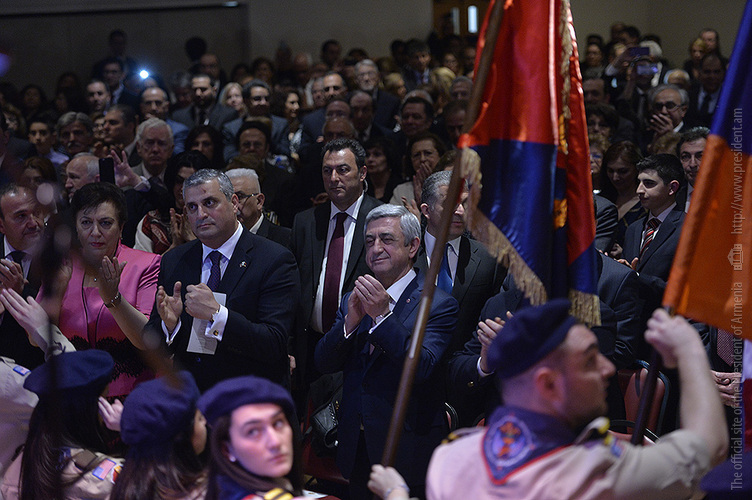
Putting together the coverage on Armenian President Serzh Sargsyan’s recent visit to Massachusetts, I get the following impression: a reporter preparing a story for Armenian media is faced with the purpose of what will the “higher-ups” say, while an American reporter, what will “those below” say; that is, their audience. By the way, the Armenian-American press in this matter proved itself to be more in line with the logic of Armenia’s media.
As a consumer, also as a journalist, and, why not, also as a citizen of Armenia, I prefer the American journalist’s rendering, because it’s more interesting. Because I want to know not only protocol information, not only the content of official speeches, but also to see what sort of person the president of my country is, in between official interactions.
And, what is not that interesting for the non-Armenian US audience, I also want to know what issues that concern us and them did young local Armenian students and diasporan Armenian figures, scientists, and entrepreneurs raise with the Armenian president… but it was generalized, more so on what the topic of conversation was and that’s it.
There were two TV reporters from Armenia in the state of Massachusetts during that time — from Armenia TV and the Public TV of Armenia. Their coverage was quite full and robust, but, as with everyone in Armenia, when an event related to the president is being covered, the portion of protocol information was unduly predominant in their reportages: they greet the president, the president standing close to the platform gives a speech, sitting are such-and-such people, one or another of whom speaks for the reportage.
It’s not bad, if others also speak. But what are they saying? They asked him either something general and abstract or to describe in what sector he has made great achievements. I realize that the person asking these questions is perhaps not the person preparing the reportage, but having considered the person sitting in front of the TV, you can also satisfy their interest, no?
For example, in his speech at MIT President Serzh Sargsyan said something like this: “Mr. Afeyan, […] I am publicly asking you to establish a very smart company also in Armenia…
Scientist, entrepreneur Noubar Afeyan was there; he was also in the Public TV of Armenia’s reportages, with his brief remarks. There were also details about his famous company, but what Afeyan thinks about the president’s specific proposal remained unknown: he wasn’t asked. We also didn’t find out whether Afeyan intends to begin work in Armenia as well — a man about whom Forbes recently published a lengthy piece with the tagline “Starting one successful company is a fine achievement. How does one describe someone who has helped found 38 companies?”
As for the president’s even if interesting protocol interactions, the Armenia TV reporter was trying to introduce them in between but by retelling [AM]. For example, the dean of the Fletcher School of Law and Diplomacy at Tufts University, greeting Sargsyan, said he has good news and bad news. The good? Armenia’s flag is outside the entrance. The bad? The elevator’s out of order; they have to climb the stairs to the 7th floor. Sargsyan responds: what bad news? It’s exercise!
Or this: “Serzh Sargsyan instructed the photographer, David, you’ll send the photos one by one to everyone.”
Why these interesting snippets are delivered in TV broadcasts by retelling, I don’t know: is it a technical issue or is showing the president in a non-protocol, simply human situations not allowed?
When the US president dances the tango at an official state dinner, we show it with great pleasure — and we watch it with great pleasure too.
That Armenia’s president knows how to dance, including the tango, I, for one, have no doubt. Moreover, both as a citizen of this country and as a journalist, I would very much like for that not to be considered an “inappropriate” subject to be shown or described in the media. Otherwise, the “rumor-mongerers” of social media begin to take advantage of this unmet public curiosity.
Let’s accept “tango” as a conventional, general word for those situations where an official is presented as simply a person, as one of us.
The US has known about this secret for a long time. And during Armenia’s 1998 presidential election campaign, based on an idea by Armenian-American Gassia Apkarian (who later became President Robert Kocharian’s public relations advisor), candidate Kocharian was depicted also playing basketball.
Apkarian also worked at US presidential candidate Al Gore’s election headquarters. She was greatly criticized that she has no idea that American “methods” don’t work in Armenia. The basketball scenes were also criticized, but no one can say whether the public was against those images or they were a good opportunity for criticism by his opponents.
But the public is the same all over the world: when we depict the country’s leader only as above everyday life, only as a person engaged in the task of managing a country, we practically equate him with a god. In that case, we should also see the other side of the coin: when a person finds himself in the worst circumstances, instead of correctly understanding and finding solutions to the cause of his problems, he rebels against god himself: the neighbor offended him, the god-president is to blame; he’s dissatisfied with the court, same; his employer hasn’t paid his salary for months, again the god-president is to blame.
Ruzanna Khachatrian
The views expressed in the column are those of the author's and do not necessarily reflect the views of Media.am.

Add new comment
Comments by Media.am readers become public after moderation. We urge our readers not to leave anonymous comments. It’s always nice to know with whom one is speaking.
We do not publish comments that contain profanities, non-normative lexicon, personal attacks or threats. We do not publish comments that spread hate.